Review: The Chieftains’ UMS Show at Hill Thrills Fans
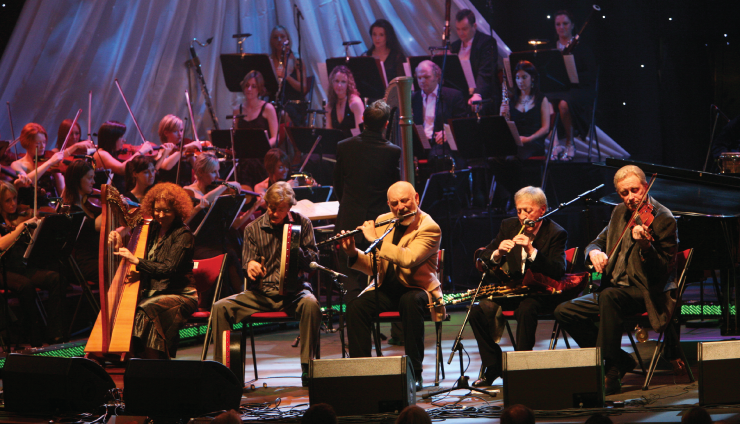
Just a wee bit in advance of St. Patrick’s Day, the University Musical Society brought the Chieftains to Ann Arbor’s Hill Auditorium on Saturday, March 5th. And if this charming, 90-minute show failed to get you in the mood for the holiday, nothing would.
The Chieftains have been torch-bearers, and set the gold standard, for Irish music for more than half a century now. One of the group’s founding members, Paddy Moloney, still sings and plays the pipes and tin whistle at center stage. The band’s current roster also includes Tara Breen (violin, saxophone, dance), Jon Pilatzke (fiddle and stepdance), Kevin Conneff (bodhran and vocals), Matt Molloy (flute), Triona Marshall (harp and piano), and Tim Edey (guitar and accordian), with featured stepdancer Nathan Pilatzke, and featured vocalist and dancer Alyth McCormack.
The Chieftains – perhaps not surprisingly, given their longevity – have a pitch-perfect sense of balancing up-tempo, foot-stomping reels with more delicate numbers. Following a spirited fiddle solo (and dance) by Breen early in the show, Conneff sang “The Flower of Magherally,” largely without any musical accompaniment, letting us focus entirely on the melody and story. Then a quick take on “Cotton Eyed Joe” played out before McCormack appeared on stage to sing the moving ballad, “The Foggy Dew” (previously recorded by the Chieftains with Sinead O’Connor).
With such a vast catalog of music from which to choose, the Chieftains inevitably venture beyond the songs most familiar to fans. Among “new to me” offerings were: the Chinese tune “Full of Joy” (not my favorite, but a clear demonstration of the group’s commitment to sharing not just their own culture’s music); an inspired, gorgeous harp solo, masterfully delivered by Marshall; a song for Nelson Mandela titled, “The Troublemaker’s Jig”; and a musical reading of W. B. Yeats' poem, “Never Give All the Heart.”
But the Chieftains also offered tunes from the documentary television series The Long Journey Home (about Irish migration to the United States), including the American standard “Oh Shenandoah,” accompanied by the Ann Arbor Grail Singers. Indeed, several local groups were integrated into Saturday evening’s show, including Lansing’s Glen Erin Pipe Band (featured most prominently in “San Patricio”), and young students from Plymouth’s O’Hare School of Irish Dance.
This leads me to mention the electrifying role dance played in Saturday’s show. Though Breen was the first to put down her violin, various combinations of dancers performed throughout the show, and the consequence was consistently thrilling.
Most breathtaking of all were the Pilatzke brothers, whose percussive, perfectly synced, wildly complex dances conveyed a palpable sense of joy. I cheered every time they made their way back to the stage’s dance space. Something about their connection to each other amped the energy even higher, and in one instance, as they danced without music, they reminded us that, sometimes, the dance and the music are one and the same.
As the show neared its end, Moloney thanked the crowd and said, “This is one of our very favorite venues,” then played an encore and invited people from the crowd to join in a traveling dance line that moved through the aisles before heading back to the stage. Several fans rushed across their rows to take part, demonstrating the crowd’s unbridled enthusiasm for the show. With everyone’s hands joined, raising and lowering in time together, the moment seemed a wholly fitting conclusion to a night that felt so heartwarming and hopeful.
Jenn McKee is a former staff arts reporter for The Ann Arbor News, where she primarily covered theater and film events, and also wrote general features and occasional articles on books and music.
Preview: Stratford Festival Offers Variety at a Good Exchange Rate

The Stratford Festival, an annual, Canadian theatre festival, is set to begin in April and this year's lineup is typically wide ranging, with 13 plays at four venues.
As always, Shakespeare is the heart of the festival. This year, the Bard is represented with productions of Macbeth, As You Like It and a reworking of Richard II, Henry IV, Part 1 and 2, and Henry V into two plays under the title Breath of Kings. The presentation was conceived and adapted by Stratford veteran Graham Abbey.
Shakespeare, himself, is the lead character in a new stage version of the Oscar-winning film Shakespeare in Love. The comedy sets the young playwright in an Elizabethan setting that is not too different from our own.
The two musicals both have theatrical themes. A Chorus Line is a tribute to modern troupers and Stephen Sondheim's A Little Night Music, an adaptation of Ingmar Bergman's Smiles of a Summer Night, with the hit song "Send in the Clowns."
Every year, Stratford presents a production geared for families. This year it's a stage adaptation of C.S. Lewis's popular fantasy The Lion, the Witch, and the Wardrobe.
Arthur Miller's All My Sons is a modern Shakespearean tragedy of blind betrayal in the story of an airplane manufacturer who cuts corners to save money during World War II.
Other works are Moliere's comedy The Hypochondriac, Henrik Ibsen's John Gabriel Borkman, and the world premiere of two contemporary plays, Aeneid, a modern take on Virgil's epic poem, and a comedy, Bunny.
This is a good year to check out the festival at bargain prices. The value of the Canadian dollar has been falling. Recently the U.S. dollar was worth $1.40 Canadian. That's good news for thrifty theatergoers for tickets, hotel rooms, and restaurants.
The season begins in April and runs through the end of October.
Hugh Gallagher has written theater and film reviews over a 40-year newspaper career and was most recently managing editor of the Observer & Eccentric Newspapers in suburban Detroit.
For more information, check out the Stratford Festival website or call 1-800-567-1600.
Preview: Rosencrantz and Guildenstern are Dead, Ann Arbor Civic Theatre
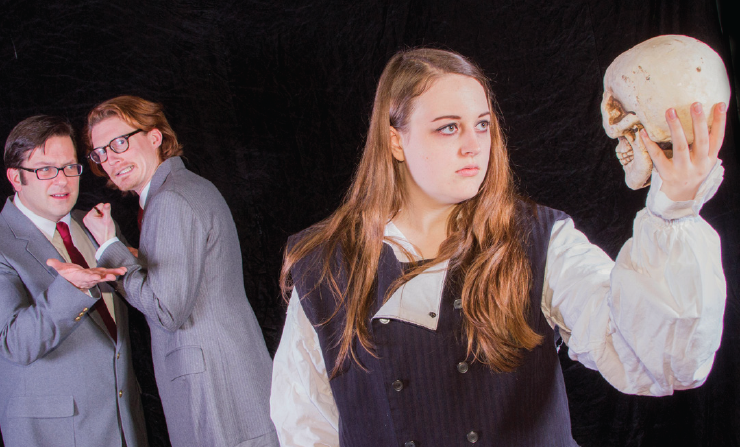
This year marks the 400th anniversary of the death of William Shakespeare.
Ann Arbor Civic Theatre, who began their season with an excellent staging of Julius Caesar, again salutes the famous playwright with a production of Tom Stoppard’s Rosencrantz and Guildenstern are Dead, the masterpiece of tragi-comic absurdity highlighting the misadventures of several characters from Shakespeare’s Hamlet.
Using two of the tragedy’s minor characters, the courtiers Rosencrantz and Guildenstern, as its centerpiece, the play premiered in London in 1967 before becoming a critical hit on Broadway, winning the Tony Award and Drama Critics Circle awards for Best Play. New York Times critic Clive Barnes wrote that the play was “very funny, very brilliant, very chilling” and stated that, “in one bound Mr. Stoppard is asking to be considered as among the finest English-speaking writers of our stage, for this is a work of fascinating distinction.”
Civic Theatre first tackled Rosencrantz and Guildenstern twenty years ago in its 1996-97 season. David Widmayer directs the current production, and, in addition to his fondness for the play and love of absurdist theater, is particularly excited about the original music created for the production and how it fits each character.
Local audiences will recognize veteran actors Isaac Ellis and James Ingagiola who portray Rosencrantz and Guildenstern. Other famous characters include Hamlet (Suzy Culbertson), Horatio (Chris Grimm), Claudius (Greg Kovas), Ophelia (Amanda Photenhauer), Gertrude (Christina Sauer), and Polonius (Elizabeth Wagner). Music direction is by Michael Edwards and the fight sequences are choreographed by Melissa Freilich.
Tim Grimes is manager of Community Relations & Marketing at the Ann Arbor District Library and co-founder of Redbud Productions.
Performances of Rosencrantz and Guildenstern are Dead run Thursday – Sunday, March 10-13 at the University of Michigan’s Arthur Miller Theatre, 1226 Murfin Ave, 48109. Tickets are available online at www.a2ct.org, by calling the office at 734-971-2228, at the A2CT office at 322 W. Ann St., or at the door. Additional information is available by visiting www.a2ct.org.
Review: Live from London: Les Liaisons Dangereuses
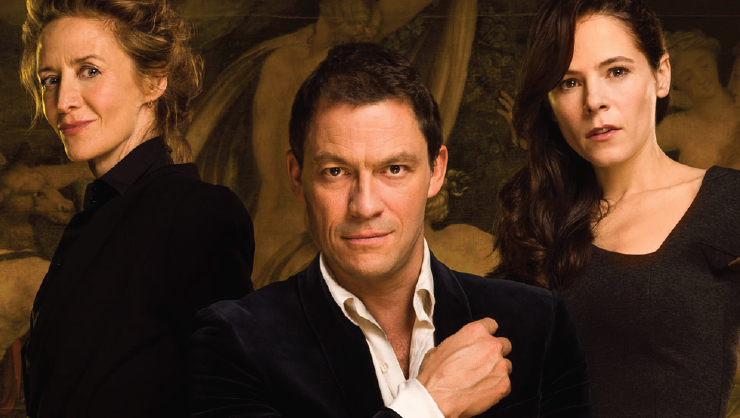
On Wednesday, February 17th, the Michigan Theater broadcast a stage performance of Les Liaisons Dangereuses through Britain's National Theatre Live. Directed by Josie Rourke, the production marks the 30th anniversary of Christopher Hampton’s adaptation of the original novel by Pierre Choderlos de Laclos.
Set in pre-revolutionary France, Les Liaisons Dangereuses tells the story of the beautiful Marquise de Merteuil, played by Janet McTeer, and the dashing Vicomte de Valmont, played by Dominic West, former lovers who now amuse themselves in a friendly competition of seduction and manipulation. The two are having a grand old time toying with their peers when the Vicomte unexpectedly falls in love with his newest mark, the virtuous and beautiful Madame de Tourvel (Elaine Cassidy).
The Marquise was the real standout in this performance. We so rarely get to see female characters like her: intelligent and witty, but also deeply flawed, scarred by her fight for independence. The Marquise is a woman who ruins the lives of others for petty revenge or jealousy, but who also fights ferociously to secure and defend her own freedom. Her ability to carry out her schemes in a world where the cards are so deeply stacked against women is a testament to her more admirable qualities. McTeer’s performance as the Marquise was incredible, bringing true range of emotion to a character that could easily have been played as a pure villain. West and McTeer had a definite rapport that underlined an unspoken jealousy between the characters that motivates many of the actions later in the play, as the personal stakes for the pair are quietly pushed higher and higher.
The sumptuous costumes and candle-lit scenes created a feeling of unsustainable decadence completely taken for granted by the French nobility. Within this splendor, the manipulative games played by the Marquise and Vicomte can almost seem frivolous. Their machinations ultimately boil down to trivialities, except that the emotions and lives of those involved, including the supposed masterminds, are so deeply affected. This production did an excellent job of laying out the emotional field of the characters, ensuring that each betrayal and revelation was felt like a twist of the knife, drawing the audience into a world where reputation and appearances are everything.
I entered this viewing with zero background for Les Liaisons Dangereuses, but I now understand why the play has been so successful. The story is well balanced, the events spooling out in a way that keeps you entirely engaged with the action. I think the secret of Les Liaisons Dangereuses is the attraction of watching a scandal develop before you, with no threat to your own reputation, almost like a guilty pleasure. Part of the reason the play is so effective is that you want to see what happens next, and so the audience is in some ways implicated in the games of the Marquise and Vicomte.
Audrey Huggett is a Public Library Associate at AADL and agrees with Dominic West that people look much more attractive by candlelight.
Preview: The Ark's 29th Annual Storytelling Festival

Humankind’s oldest art form is also the basis of one of The Ark’s longest running events. This year marks the 29th Anniversary of The Ark’s Annual Storytelling Festival, a two-night event that brings the oral tradition from the primordial bonfires of yore to The Ark’s warm and welcoming concert hall. Saturday night this year’s featured storytellers will spin yarns geared toward a mature adult audience, and Sunday afternoon they’ll switch gears to entertain an all ages crowd.
Over the years the festival has welcomed a bountiful mix of perspectives and storytelling styles, and this year is no exception. This weekend’s three featured storytellers -- author, playwright, storyteller, and NPR correspondent Kevin Kling; acclaimed musician and children’s entertainer Bill Harley; and local Irish performer Yvonne Healy -- spoke to me about what kinds of stories they will tell each night, and how their work has changed with the rise of radio storytelling shows like The Moth and Snap Judgement.
Headliner Kevin Kling is known for his humorous personal stories about his Midwestern upbringing and his experience with physical disability. Though he has been featured regularly on NPR’s “All Things Considered,” Kling says he prefers performing in front of a live audience.
“Garrison Keillor really put us on the map, and somebody said, I thought very accurately, that he plays a microphone like a Stradivarius,” Kling says of his distinctly Midwestern colleague. “He's so wonderful on the radio. He really has found that medium. I'm a bit different in that I love a live audience. There's something visceral and chemical, something that happens on stage that neither sound waves nor lightwaves can quite fill. That to me is the magic of a live performance. You don't see a lot of standing ovations in front of the radio.”
Kling says he always knew he wanted to be a performer, but early on he had no idea he would get paid to simply stand on stage and talk about his life. He says his professional career as a storyteller began in that most fabled of artistic proving grounds: the dinner party.
“I was in the kitchen at a party, you know that's always the best place, and I was just blabbing away,” he says. “Little did I know there was a theater producer in the kitchen and she said, ‘Do you want to be in our season next year?’ And I said, ‘Doing what?’ And she said, ‘Just what you did in the kitchen.’ Before I knew it, before I knew what I was, I was on stage telling stories in a theater in Minneapolis. And then I went to Seattle, and then off-Broadway, doing pretty much what I did in that kitchen.”
Kling says he doesn’t know exactly which of his two-hundred-plus stories he will tell this weekend. He likes to show up to a venue with a good chunk of his repertoire in mind and read the crowd before deciding where to take the audience for the evening. One topic he is certain he will touch on, though, is disability, something he’s an expert on. Kling was born with a deformed left arm, and he lost the use of his right one after a near-fatal motorcycle accident. Still, he assures us he’ll keep things as light as possible no matter how serious the subject matter he chooses to delve into might be.
“It will be done with humor,” he says. “That's the best way for me to get through that because you can laugh at something that doesn't control you anymore. Everybody in the audience knows loss. People say, ‘What's the difference between stand-up comedy and storytelling? You close a door with a joke with comedy, but with storytelling you open a door with a joke. It's like you're saying, ‘Now that we're all here, let's get to it.’’
Joining Kling on stage this weekend is another nationally renowned storyteller, Bill Harley. Dubbed “The Mark Twain of contemporary children’s music,” Harley pairs wit, humor, and song to embellish tales of his childhood, coming-of-age, and family life.
When asked why he is drawn primarily to telling stories from his youth, Harley responds, “I find that if I talk seriously about childhood, then everybody usually comes along. That's the birthplace of our disaster, so that's pretty fertile territory.”
Harley says he probably won’t tailor the topics of the tales he chooses for the adult and family sessions this weekend, but rather the manner in which he tells them.
“It's not so much structure as it is language, nuance and subtext,” he says. “If you talk about childhood or coming-of-age seriously, those experiences we carry with us through our whole lives, everytime we touch on those experiences it brings up something that touches us, that reaches adults just as much as it does younger kids. Obviously with the family show, I'm less likely do to do a 40-minute story. With a family show you can't mess around. You've got to keep your pedals moving and your foot to the floor and be very aware of what`s going on. With adult performances, there's a lot more nuance, and there's a lot more chance for discovery.”
Harley’s performances will ensure the melodic comfort The Ark typically traffics in won’t be entirely lost for the weekend. He says audiences are often surprised and delighted by the way he flirts with the intersection between song and spoken word.
“When you sing a song, people go, ‘Okay, we know that,’” he says. “And then you put your guitar down or you're holding your guitar and you start to talk, and all of a sudden people are kind of waiting for the talking to end and the music to begin again. And slowly, they realize this is something other. I always have people come up to me and say, ‘I haven't been to something like this for years. I can't remember the last time I sat and listened to something like that.’ It's an amazing experience.”
Local Irish storyteller Yvonne Healy rounds out this weekend’s bill with a rollicking blend of traditional Irish folklore and mythology and flamboyant tales of her own personal experience. Healy, now a resident of Howell, was born in Ireland and raised in the U.S. She says her upbringing straddled the cultural mores and traditions of both countries and gave her a master class in the art of storytelling.
“Inside the house was Ireland, and outside the house was the United States,” she says. “So inside the house we spoke Irish, and we danced Irish dances and sang to Irish music. We behaved in an Irish way, and part of that is learning to tell stories properly, with proper accent and proper detail. I learned by rote, phrase by phrase.”
Healy’s father had a profound influence on her interest in telling stories. She describes him as an alternately charming and argumentative contrarian who could worm his way out of any situation with a good yarn.
“I asked him one time, ‘How is it that you never get beat up?’ And he said, ‘Well I got beat up once. Now, whenever I get to that point, and I like getting them to that point, then I tell them a story and confuse them. And then they let me go.’ So really, talking is a martial art.”
Like this weekend’s other two storytellers, Healy says she doesn’t yet know exactly what stories she’ll bring to the stage. She says Sunday she will stick to traditional folklore and mythology because she believes children, who are are developing their perspective on life, need the neatness of literary devices and literary structure. For Saturday night, she says she will cull stories from her own life. With more and more people being introduced to live storytelling via NPR, she says that seems to be what people want to hear these days.
“I think it’s because we have such an educated populace,” she says. “We can figure out where stories are going to go, but real life is not neat like a fictional story is. Real life is messy and doesn't have those kind of fictional constructs, and so that's very interesting to us. We spend a lot of time alone or with screens in our contemporary society, and I think having deep, real conversations with other people face-to-face is very moving for everybody.”
Healy elaborates on that last remark. Live storytelling, she says, is a conversation between the performer and the audience.
“The story changes depending on how the audience reacts,” she says. “If you're losing some people in some place, you kind of come back and go back into the thread and go off on another digression, but only if the audience is responding to it. A story is really co-created by everybody in the room.”
Steven Sonoras is an Ypsilanti-based freelance writer, and he would love to tell you the story about the time he saw a UFO.
The Ark’s 29th Annual Storytelling Festival runs Saturday at 7:30 p.m. & Sunday, at 1 p.m. The Ark is located at 316 S. Main St. Tickets are on sale now through the Michigan Union Ticket Office and at The Ark's website. Tickets are priced at $20 for the Saturday evening show and $10 for the kids’ show on Sunday afternoon.
Review: U-M's Clybourne Park Finds Deep Humor in Our Sad Racial Dance
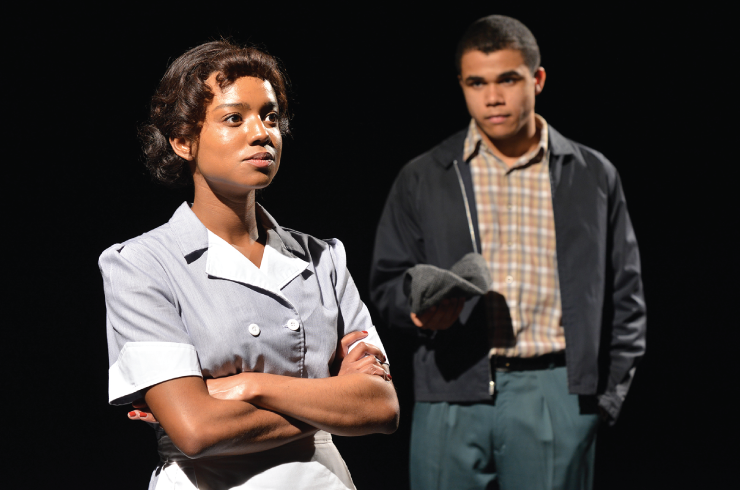
It's still an awkward dance. When it comes to the subject of race, we seem to invent new language just to avoid the blunt words and ingrained feelings that are simmering just below the surface.
There are few places where that is more true than southeastern Michigan with a long, bloody history of racial animus. Flint and the Detroit school situation are just the most recent examples of the unresolved prejudices that politically correct speech can never hide.
The University of Michigan's School of Music, Theater and Dance couldn't have picked a more relevant and powerful play than Bruce Norris' Clybourne Park. But be warned, anyone expecting a sermon on race relations will find instead a hilariously serious comic drama. This is a play that exposes that awkward dance with sharp wit and a rare ability to understand the real complexity of the issue. The play has won the triple crown of theater awards, the British Olivier, Broadway's Tony, and the Pulitzer Prize and this U-M production is brilliant at making us laugh while unpeeling the many layers of code words that separate us.
406 Clybourne Street is the house in a white Chicago neighborhood that a black family moved into in Lorraine Hansbury's 1959 play A Raisin in the Sun. The first act of Norris' play set in 1959 centers on the white couple who have sold this home and are anxious to move out to escape the pain of the death by suicide of their Korean veteran son. The second act takes place in 2009 as an upscale white couple are meeting to discuss plans to modernize the now ravaged home in what has become a low-income black neighborhood.
This is serious stuff. But even in this first act director John Neville-Andrews uses Norris' stylized speech moving at a brisk pace, perfectly capturing the various anxieties at 406 Clybourne. The second act moves at an even faster pace, with more laughs but also more direct confrontation. His cast handles this very precise language skillfully, capturing every nuance of meaning and wringing every bit of the humor that dulls the deeper pain. In addition, each actor in the play has two distinctly different characters. That transformation is awesome.
In Act One, Jack Alberts is Karl, a leader of the community association, who comes to warn Russ and Bev that selling their house to a black family will lead to the end of their tight, white community. Alberts' Karl is a tightly wound, nerdy accountant type. He can't let a bad argument go, he can't let anyone else get a word in to dispute his notion that mixing races is a bad idea. His tight suit and undersized fedora perfectly highlight Alberts' performance. In Act Two, Alberts is Steve, a modern, hip guy, a real urbanite who wants to come back to the city and make it new again. This is where Alberts really nails the character, a slick guy who thinks he's post-racial, until he finds out he's not.
Lila Hood plays Karl's sweet, deaf wife Betsy, a victim of another kind of mindless patronization, and Steve's very modern wife Lindsey, an urban woman who claims at one point "half my friends are black." Again, Hood plays two characters who couldn't be more different and captures the sadness and isolation of Betsy and the whip-smart intelligence and total cluelessness of Lindsey.
David Newman goes from depressed father Russ in Act One, to broad comic punctuation as a construction worker in Act Two. His performance as Russ explodes as he makes a case that not all decisions hinge on the issue of race, even in Chicago. It is a plea for the personal over the social and political. His comic turn is a complete turn around.
Madeline Rouverol is the center point of Act One as Bev, a woman with high anxiety over the death of her son and the increasing depression of her husband. She talks a blue streak, she fidgets, she gushes. And when it comes to relating to her black maid, she displays the easy bigotry that passed/s for liberalism. She thinks she and the maid are friends, how quaint and how sad. In Act Two, Rourverol is a real estate lawyer, Albert and Betsy's daughter, who also thinks she's free of prejudice. Rouverol gets some very funny lines here that she places with pinpoint timing.
And about that maid, Francine. Blair Prince is devastating in this pivotal role. She presents herself as a dutiful employee, even as she is about to lose her job. But she's not one to be pushed around and she disdains Bev's phony liberal overtures (bribes), with looks that would wither a forest. When confronted by Karl to stand in for her race and answer his absurd challenges she dances to avoid and not offend while clearly showing that she is deeply offended. In Act Two, the tables have turned. She is the educated, tart tongued Lena, defending her community against its impending gentrification. It was her family who moved into 406 Clybourne. But here again, she dances around the issue until push comes to shove. Prince shows all of this in her expressive face.
Aaron Huey is Francine's kindhearted husband Albert, who shows that slowly dying deference to whites that makes old movies so uncomfortable. But Huey's Albert also shows his real feelings in his face and when things get a little too insulting he reacts with quick wit. As Lena's husband Kevin, he is a young professional at ease with whites, sharing similar interests, knowing the same people, sharing the same good life in Chicago. But as Act Two goes on, the bonhomie gets thin and then explodes and Huey masters that slow burn.
Jordan Rich plays Jim, a minister in Act One, who tries to straddle two contradictory ideas at once and do it with Christian charity. The temptation to overplay this sanctimony is avoided and Rich makes the character real. In Act Two, he's a building inspector who acts as a referee as the conversation moves from funny to dangerous. He gets one of the night's funniest lines.
The set design by Gary Decker is superb. In Act One, the house is a solid, old Chicago house, real wood trim, plaster walls. It's untidy only because the moving boxes are scattered about. In Act Two, fifty years of increasing poverty and the neglect poverty causes are evident in the home that is also in the early stages of demolition. The change is eye-popping.
Hugh Gallagher has written theater and film reviews over a 40-year newspaper career and was most recently managing editor of the Observer & Eccentric Newspapers in suburban Detroit.
Clybourne Park continues 8 pm Friday and Saturday, Feb. 19-20, and at 2 pm Sunday, Feb. 21, at the Lydia Mendelssohn Theater on the central campus of the University of Michigan. Tickets at the League Ticket Office, (734) 764-2538.
Feeling Cross: David Cross at the Michigan Theater

Downtown Ann Arbor shivered with excitement and near-frostbite as over 1,000 comedy-lovers flocked to Michigan Theater on Saturday, February 13 for David Cross's Making America Great Again tour. The return of this stand-up legend was an event not to be missed.
Even if you don't recognize Cross by name, it's likely you've encountered his work before. Maybe you've seen him in the cult tv show Arrested Development, heard his voice in the Kung Fu Panda series, or stumbled upon his sketch show W/ Bob & David on Netflix. He's kept busy over the last twenty years recording comedy specials, starring in The Increasingly Poor Decisions of Todd Margaret, and popping up in shows like Modern Family and Archer. One of my favorite little facts about Cross (there's no stopping this train now) is that he appears in both Men in Black and Men in Black II as completely different characters. (Not that you need an excuse to watch MIB.)
As a first-time visitor to the Michigan Theater, I was admiring my surroundings when someone extremely exciting took the stage to make an announcement. It was an American Sign Language interpreter. I couldn't help but wonder if this man would be interpreting the entire performance, because as a fan of David Cross's previous work, I knew what levels of vulgarity were possible. Where would the line be drawn for ASL interpretation?
Suddenly, the music got louder. Actually, it was deafening, but then I started picking up lyrics about a show...did I hear "David Cross?" I knew for certain this was the Making America Great Again theme song when I heard the phrase "turn off your cell phones or you'll be punched in the dick." This was going to be a good show.
Cross emerged with a beard even lumberjacks would envy. He wore a baseball cap, jeans, and a blue zip-up sweatshirt reminiscent of his Arrested Development Blue Man Group costume. Even Cross was completely entranced by the ASL interpreter. He tried a couple of test words, including "Ethiopia" and "Sputnik." Other, more...mature words definitely happened. This interpreter was legit.
Then came the traditional introductions, a time when performers compliment the town they're visiting to the delight of their audience. Cross mentioned that he'd been walking around town, and I later heard he'd been to HopCat. So what did David Cross have to say about Ann Arbor? "It's ok." He followed up with the question, "Is Ann Arbor still the most literate city in America?" and in response to audience applause, "Good for you."
Throughout the show, Cross paced along the stage, spouting what sounded like stream-of-consciousness commentary, jumping from one topic to the next effortlessly. His jokes reflected real life, from dysfunctional family gatherings to religion to politics. Surprisingly, despite the name of his tour, certain Republican presidential candidates were only mentioned in passing. More time was devoted to advocating for gun regulation; he sarcastically vented that "there's nothing more American than reading about a senseless...gun death."
Cross paused his ranting periodically to interact with an intoxicated audience member. Their banter seemed so natural that I started to wonder if she was an intended part of the show. Eventually, he gave in to her interruptions and handed her the microphone, and she sent her "peace and love to everyone." Cross, with total professional ease, chuckled and proceeded with his show saying, "So that was a little bit fun."
The night seemed to end before it started, and when it was over, Cross reemerged from backstage to take a group photo of the audience for his facebook page. If you missed the show this time, dry those tears! Rumor has it that Cross will record his performance on Friday, April 22 as a comedy special.
Kayla Coughlin is a Library Technician at the Ann Arbor District Library and is intrigued by American Sign Language possibilities.
David Cross returns to Michigan on Thursday, March 18, 2016, appearing at the Fountain Street Church in Grand Rapids.
Review: You’ll Laugh, You’ll Cry, You’ll Learn Absolutely Nothing: Taylor Mac and His History of Popular Music
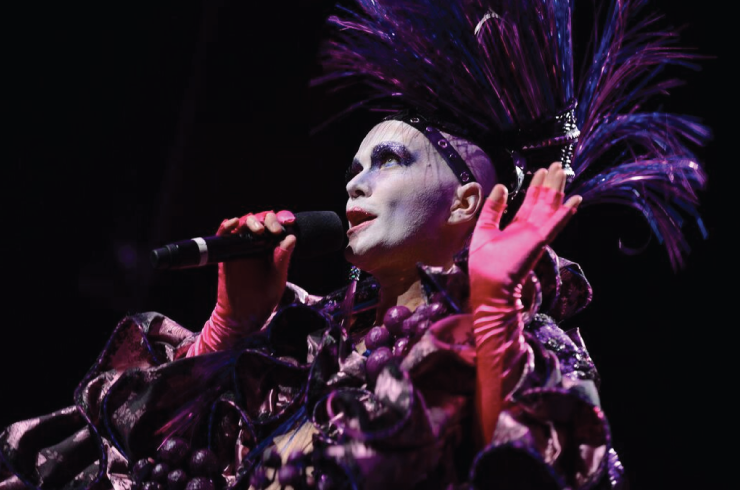
Taylor Mac is not a teacher. If you’re interested in learning history—take a class. Read a book. Get sucked deep into a Wikipedia black hole and hang out for a while.
On Saturday, February 6th, actor, performance artist, and drag queen, Taylor Mac gave a performance of his A 24-Decade History of Popular Music that made me laugh, made me cry, and made me extremely uncomfortable. The only thing it didn’t do was teach me any history. Which, considering just how much it attempted to do—and successfully managed—was not such a big surprise.
Hosted by the University Musical Society, the show was part stand-up routine, part concert, part drag-show, and part performance art. I have no words for this sort of performance amalgamation, and so I was perfectly willing to accept Taylor Mac’s own description of the event as a “radical fairy realness ritual.”
From the start, it was clear that the event would be unusual. Our host, Taylor Mac, came on stage in a hot pink skirt suit spray painted with an American flag on the back, a sash made of soup cans, and a jaunty little hat. Behind him on stage sat a band of seven musicians—a pianist, a bassist, a drummer, a guitarist, a guy who seemed to be playing a different instrument every time I looked at him (saxophone, trumpet, flute, possibly the flugelhorn), and finally, two exceptionally powerful back-up singers.
Mac began the show by explaining the bare bones of his musical project—each hour of the three-hour performance would be dedicated to a different ten-year period: 1956-1966, 1966-1976, and 1976-1986. Each decade came complete with its own costume, eight or nine songs from the time, and a central historic theme. This performance was just a fraction of a much larger endeavor Mac has planned for a later date, a 24-hour performance with an hour for every decade from America’s inception in 1776 all the way up to the glorious pop-fest that is the year 2016. Mac explained the idea that he would be on stage for a full 24 hours, singing and entertaining non-stop without food, bathroom, or sleep breaks, with the casual air of someone who is either very confident or incredibly irresponsible. Possibly both.
Probably both.
The first decade of our less-ambitious 3-hour show, ’56-’66, focused on aspects of the Civil Rights movement, or, as Mac puts it, “Songs Popular in the Bayard Rustin Planning Room.”
It kicked off with a slow and sultry rendition of Jay Hawkins’s “I Put A Spell On You.” By itself this would have been excellent entertainment—Mac’s stellar flair for theatrics is matched by his smooth, powerful voice. But just in case the audience had started to settle into the comfortable idea that they were at some tedious concert-meets-comedy-meets-drag-show, Mac introduced a new and terrifying element: audience participation.
After a very brief introduction of the racially tense atmosphere pervading the late ‘50s, Mac asked all of the straight, white people in the audience to stand up and slow-motion run to the sides of the room, simulating white flight.
“I understand that there won’t be a lot of room for you over there,” Mac said to the amazingly willing audience as they wiggled and stepped over each other to get to the sides of the room, “But I really want you to get the feel of the suburbs. I want you to be so close together that there’s a straight, white person on top of you even when you really don’t want a straight, white person on top of you.”
By the end of the song, I wasn’t sure if I was laughing, crying, or hyperventilating. If you’ve never seen a hundred people of all ages, including senior citizens, slow-motion run to the sides of a room and pack in like sardines, I highly recommend it.
With all of the elements fully introduced, the show really got under way. The ‘56-‘66 hour contained a bit of background on race issues and centered its attention on the March on Washington, though unfortunately most of the story that Mac told focused on the imagery of getting on a bus to go to the March. It involved an awful lot of audience playacting of getting to the bus/being on a bus/singing on a bus, without much actual information on the March itself.
Despite the fact that Mac didn’t tell much of a story, the music certainly did. The songs were well-chosen, a combination of Civil Rights anthems like The Staple Singers’ “Freedom Highway” and Nina Simone’s “Mississippi Goddam” and chart-toppers like The Supremes’ “You Keep Me Hangin' On” and Bob Dylan’s “A Hard Rain’s a-Gonna Fall.” The songs that came with their own clear message, such as the impossible-to-misinterpret “Mississippi Goddam” were as powerful as you might expect. But even the popular hits, thrown in front of the backdrop of the 1950s and forced into context gave songs like Simone’s “Don’t Let Me Be Misunderstood” deeper meaning and even greater muscle.
I’ll admit it—the ‘56-‘66 decade was definitely my jam. But the following decades carried the same sort of structure and a lot of the same impressive weight.

Curtis Mayfield’s "Move On Up" transitioned us into the 1966-1976 decade, as Mac stripped down to a tiny yellow Speedo on stage, then disappeared behind the curtain and remerged in an outfit made up of so many different things that I honestly couldn’t tell if it was a dress, a jumpsuit, or if he’d tripped and fallen into a scrap box on his way back to center stage. The whole ensemble was tied together by a rainbow cape made of clear plastic tubes and a glittery silver headdress. This era had its eye trained on the beginnings of the gay liberation movement and the Stonewall riots of 1969. Songs included Bruce Springsteen’s “Born to Run,” Patti Smith's "Birdland," and The Rolling Stones' "Gimme Shelter."
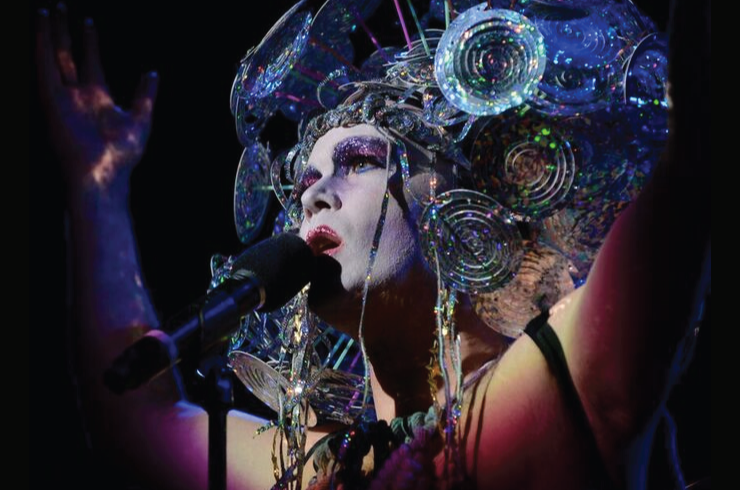
The 1976-1986 decade focused on the idea of the '70s and '80s club scene and their infamous "back rooms." This aspect of history seemed like an odd choice until I realized that these "back rooms " were a prevalent part of Mac's own experience as he came up in the club scene. Dressed in a bright silver jumpsuit with a ruffled purple shawl and a shiny purple mohawk, Mac told his most personal (and most graphic) stories during this era in between Laura Branigan's "Gloria," David Bowie's "Heroes," and Prince's "Purple Rain."
The gaps between each song were filled with comic stories, musings, and, of course, the obligatory ridiculous activities that come with performance art. During the 1956-1966 portion of the show, audience members were asked to dance, march, engage in some pretty exaggerated crying, and, finally, to email Rick Snyder.
Sometime around the 1970s, we were handed ping-pong balls to throw at Mac as he ran through the aisles in his rainbow-tube cape and yellow Speedo. As we moved into the late '70s part of the show, Mac pulled an older gentleman up on stage and sang him a love ballad, while the pianist groped the man’s leg.
In the '80s, he had an entire row of the upper balcony come downstairs, go behind the curtain onstage, and emerge in ridiculous wigs, boas, and glasses and dance through the aisles. Each activity was a bit more unbelievable than the last, finally culminating in a college-aged boy standing patiently still while Taylor Mac kissed him and rubbed glitter lipstick all over his face. Permission was not asked, just a perfunctory, “You’re over 18, right?”
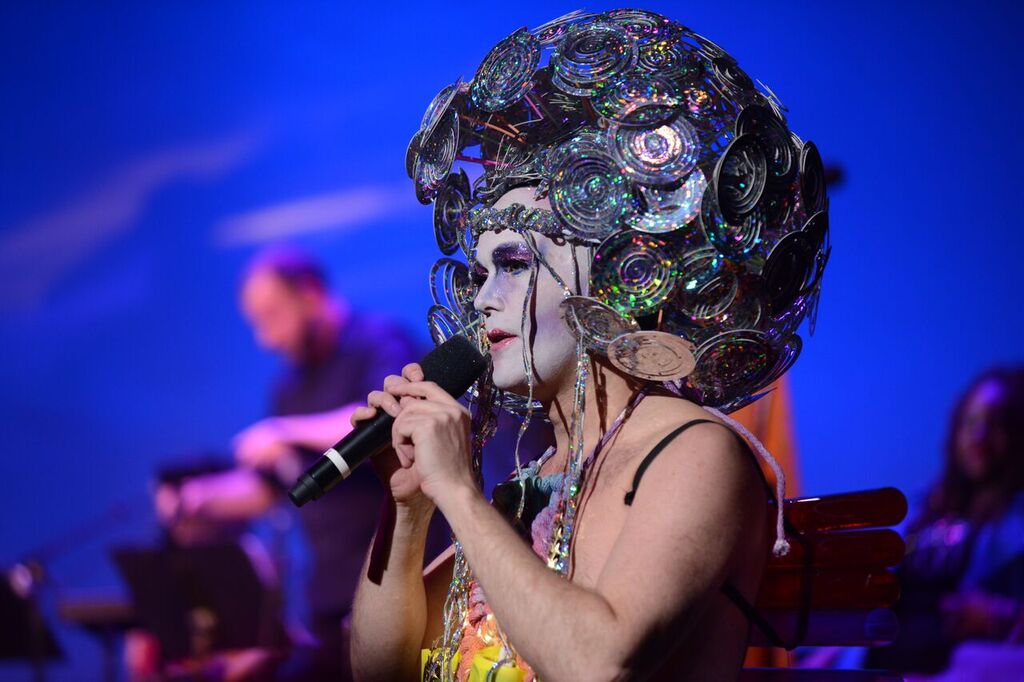
It was wonderfully weird, and, while the entire thing carried the feel of a glittery game of Russian roulette as we waited to see who would be Mac’s next participation victim, it also succeeded in doing exactly what Mac had told us it would—creating a shared experience for the audience. The audience was incredibly good-natured, dancing when asked, moving when asked, and making sure to applaud loudly and sincerely for anyone who was a good enough sport to obey instructions like, “go stand on stage, but don’t smile and don’t dance” or “lay down on the floor and let these five strangers carry you out of the room.”
From all this highly entertaining madness, I only came away with one critique. As a person who would have loved all the elements of this show even if they were completely separate and not one giant, Katamari Damacy-style ball-of-everything, I was absolutely enchanted by this performance, so much so that I didn’t even resent Mac for keeping me up past my 8 pm bedtime. Give me comedy, music, or drag any time of day and I’m game. But I was also interested in the promise of some really good history-nerd satisfaction, and so I was a bit let down by the minimal emphasis on the actual history.
While Mac did occasionally address the lack of historical fact—“If you want to know more about the March [on Washington…Google it. What about this outfit says anything more than Wikipedia?”—I felt like it was such a shame to dismiss the history so casually because of how much it could have brought to the show. Even the barest skeleton of historical facts would have ramped up the storytelling element and could have made this fun and flighty show a little bit stronger and a lot more engrossing, particularly in the gaps between musical numbers.
But considering how much it did do right, I really can’t fault it for the one thing it didn’t completely ace. The show managed to be a masterful musical performance, an entertaining drag show, and a surprisingly fun communal audience experience, so really, who cares if he didn't include a history lesson? It was still a performance I’m not likely to forget. At least, not in this decade.
Nicole Williams is a Production Librarian at the Ann Arbor District Library and, despite this positive experience, still thinks audience participation is the worst.
Preview: Clybourne Park, U-M Department of Theatre & Drama
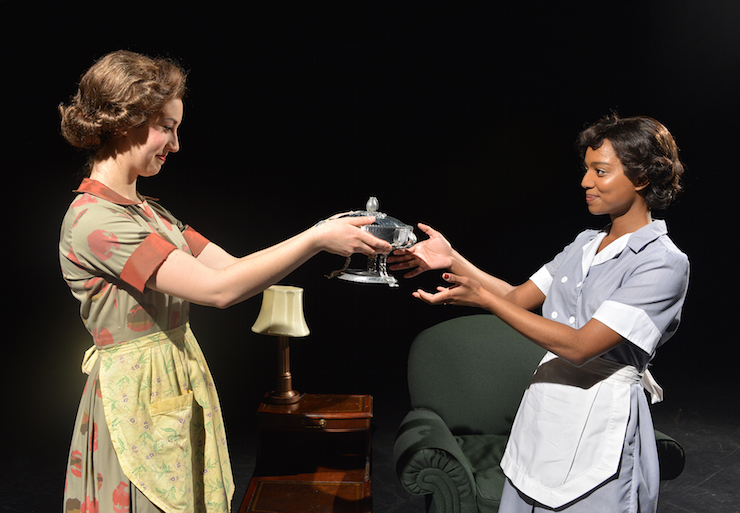
We all have regrets in life. Roads not taken….opportunities missed.
One of my major theatrical regrets of the last decade is that, in February 2010, I had the opportunity to see a new Off-Broadway play that had just opened to outstanding reviews, but chose instead to see an alternate show. I cannot remember why I chose the play I attended, or even the title; however the one I passed up won the Tony Award for Best Play (when it transferred to a successful Broadway run), the Pulitzer Prize for Drama, and the Lawrence Olivier Award for Best New Play for its London production.
The New Yorker called it “superb, elegantly written and hilarious. A master class in comic writing.” The New York Post raved that it was “Absolutely sensational! …Dazzlingly written.” The New York Daily News gave it “Four stars” calling it “A superb world premiere!”
The play was, of course, Clybourne Park, the masterful and insightful examination by Bruce Norris of racism in America set in the house soon to be inhabited by the Younger family (of Lorraine Hansberry’s classic A Raisin In the Sun). With a plot spanning half a century (Act I is set in the 1950’s; Act II is 50 years later), the play brims with humor, insight, and pathos.
Local audiences can now experience this critically-acclaimed work, a classic in its own right. Award-winning Director John Neville-Andrews leads talented U-M students in a new Department of Theatre & Drama production of Clybourne Park that promises to be an outstanding night of theater.
Tim Grimes is manager of Community Relations & Marketing at the Ann Arbor District Library and co-founder of Redbud Productions.
Performances run from Thursday, February 18 to Sunday, February 21 at Lydia Mendelssohn Theatre, 911 N University Ave, Ann Arbor. Following the Friday performance there will be a post-performance discussion moderated by Neville-Andrews with members of the cast and artistic staff. For tickets, visit music.umich.edu or call the Michigan League at (734) 764-2538.
Review: Sondheim on Sondheim Soars at Encore

Imagine you've been invited to a sophisticated party at the Manhattan apartment of the dean of American musical theater, Stephen Sondheim. In the course of the evening, guests will perform from Sondheim's rich vault of musical theater pieces that brought a new irony, maturity and depth to Broadway. And Sondheim, himself, will explain his craft, his artistic growth and his sometimes troubled life.
And it's all happening magically on Broad Street in Dexter at The Encore Theatre.
This is the set-up for Sondheim on Sondheim, a musical revue conceived by Sondheim's frequent collaborator James Lapine. A wide-range of beautiful music from the Sondheim catalog is presented by live performers while on a large screen videos show Sondheim in interviews and documentaries covering his career from his early success as a lyricist for Leonard Bernstein and Jule Styne through his career as the most successful Broadway composer of recent history. Sondheim is an engaging, witty and insightful host, willing to share the "secrets" of his trade, learned at an early age from another master, Oscar Hammerstein II. He is also quietly reflective about a lingering sadness in his life.
Four men and three women arrive on stage dressed for a cocktail party. A man sits at a grand piano going through the finger movements of a piano lesson and we're off for an evening of laughs, tears and much in between, because this is a cast that understands Sondheim.
Director Daniel Cooney was a little nervous on Feb. 5 because a cast member was unable to perform, so he was a singer short. Not to worry, with the help of a few index cards, the cast members rose to the occasion and filled in the gaps. Talk about troupers!
Cast members Peter Crist, Leah Fox, Daniel A. Helmer, Kelsey Pohl, Thalia V. Schramm, Jim Walke and Adam Woolsey make a fine ensemble around music director Tyler Driskill's skilled piano accompaniment. But they also shine on their special moments, the kind of theatrical moments that are almost exclusive to Sondheim's repertoire.
Kelsey Pohl brings sass and brass to "Now You Know" and sexual energy to "Ah, But Underneath." She has a commanding voice and energy.
Jim Walke is a big guy who gets to handle the more dangerous songs. As the mad baker from Sweeney Todd, he roars through "Epiphany" and as a potential killer from Assassins he ruminates sadly and madly on the power of a gun in "The Gun Song."
Daniel A. Helmer gets the spotlight as a feuding songwriter on "Franklin Shepard, Inc." and is fierce and funny, as he is in several ensemble pieces. He takes a quieter turn on Sondheim's best reflection on art itself in "Finishing the Hat."
Adam Woolsey offers a slow, quiet reading of Sondheim's concluding statement in Company, "Being Alive." Woolsey's version is powerfully sad with just a hint of positive self discovery. Peter Crist gets the spotlight on "Is This What You Call Love," which he sings with the right note of wounded confusion.
Thalia V. Schramm and Leah Fox perform a counter rendering of sad love-maybe songs "Losing My Mind" and "Not a Day Goes By" with all the wistful weight intended.
Schramm is also excellent on two of Sondheim's most complicated songs. On "In Buddy's Eyes," her near tears performance underlines softly the song's bitter regrets. And on Sondheim's most famous song "Send in the Clowns," Schramm delivers all the poignancy of love lost that has made the song so beloved.
Cooney's staging and Driskill's musical direction make the complex blending of video and live performance flow effortlessly. The ensemble pieces are crisp and natural. The solos are well defined. And all of it keys nicely off the Sondheim videos, which are a series of revelations.
Set designer Sarah Tanner has created an eye-popping rendering on a Manhattan apartment, meticulously decorated with show biz photos, old posters and playbills, a display of game boards and bric-a-brac. The room is appropriately furnished and looks out on a city skyline. Andy Galicki handles the complex lighting design and the precise video presentation.
Hugh Gallagher has written theater and film reviews over a 40-year newspaper career and was most recently managing editor of the Observer & Eccentric Newspapers in suburban Detroit.
Sondheim on Sondheim continues Thursdays through Sundays through Feb. 21 at the Encore Theatre in Dexter. For tickets, call the Encore Theatre box office at (734)268-6200 or visit the website at www.theencoretheatre.org/tickets/


































